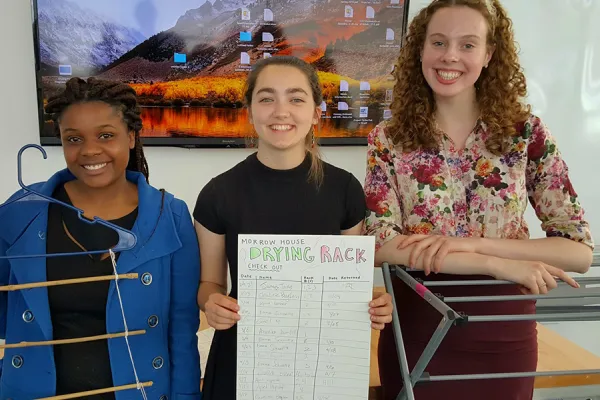A Greener Way to Dry
Sustainability

Published May 1, 2018
A modest change in Smith house living aims to have a big effect on campus energy use: A new laundry drying-rack system proposed by students in Capen and Morrow is the winner of the college’s first-ever House Sustainability Challenge.
Using portable racks—some store bought and some made by students—the system reduced by nearly 200 cycles the use of dryers in the two houses piloting the program this semester, according to challenge team members.
“Our goal was to give students a simple, accessible alternative to dryers,” explained Yolanda Chigiji ’21.
“We loved working on a project that has the potential to change the whole campus for the better,” added teammate Julianne Borger ’21.
Emma Krasky ’21, Sadie Wiese ’21 and Sophie Guthrie ’21 also were on the project team.
I learned the art of marketing an idea to a large audience and how to be human-centered when making a design
The drying rack idea was one of three finalists selected last fall in the House along with:
- A proposal to boost the efficiency of heating systems in Chase and Ziskind houses by recording real-time room temperatures and reporting potential problems to Facilities Management (Yuqing Geng ’21 and Erika Melara ’20).
- A program to reduce water use by installing shower-flow regulators in Comstock House (Katie Knowles ’19, Karime Gutierrez ’20).
Finalists were awarded $500 to pilot test their ideas this semester.
At a final challenge competition held at the Campus Center in late April, the three finalist teams used mock infomercials, charts and physical models to help convince the judges that their ideas met student needs, as well as being economically feasible, environmentally sustainable and easy to implement campus-wide.
Residence life director Rebecca Shaw, a judge for the competition, was impressed that the winning project “focused on a real problem—everyone has to wash and dry their clothes. I also really liked that the students built their own racks out of recycled materials.”
Event judge Benjamin Paquette, manager of mechanical trades in Facilities Management, hopes the winning project “will make students more aware of energy conservation and possibly inspire future students to develop more ideas about sustainability.”
René Heavlow, program director at the Conway Center, and Angela Gregory, an Ada Comstock Scholar, also served as judges for the competition.
The Capen and Morrow House team was awarded a $1,000 prize and the chance to help implement the drying-rack program campus-wide next year. The judges were so impressed by the other teams’ presentations that they awarded each of them $250.
For participants, there were additional rewards to taking part in the challenge.
“I learned the art of marketing an idea to a large audience and how to be human-centered when making a design,” said Chigiji.
“To be successful with a program, it’s necessary to communicate constantly with the people involved—in this case, our fellow housemates,” said Borger. “I’m greatly looking forward to spreading our drying-rack program to houses around campus.”
The House Sustainability Challenge was sponsored by Smith’s Conway Center for Innovation & Entrepreneurship; the offices of Campus Sustainability and Residence Life; the Center for the Environment, Ecological Design and Sustainability; and the Design Thinking Initiative.
(From left) Yolanda Chigiji '21, Emma Krasky '21 and Julianne Borger '21 were on the winning team in the House Sustainability Challenge.